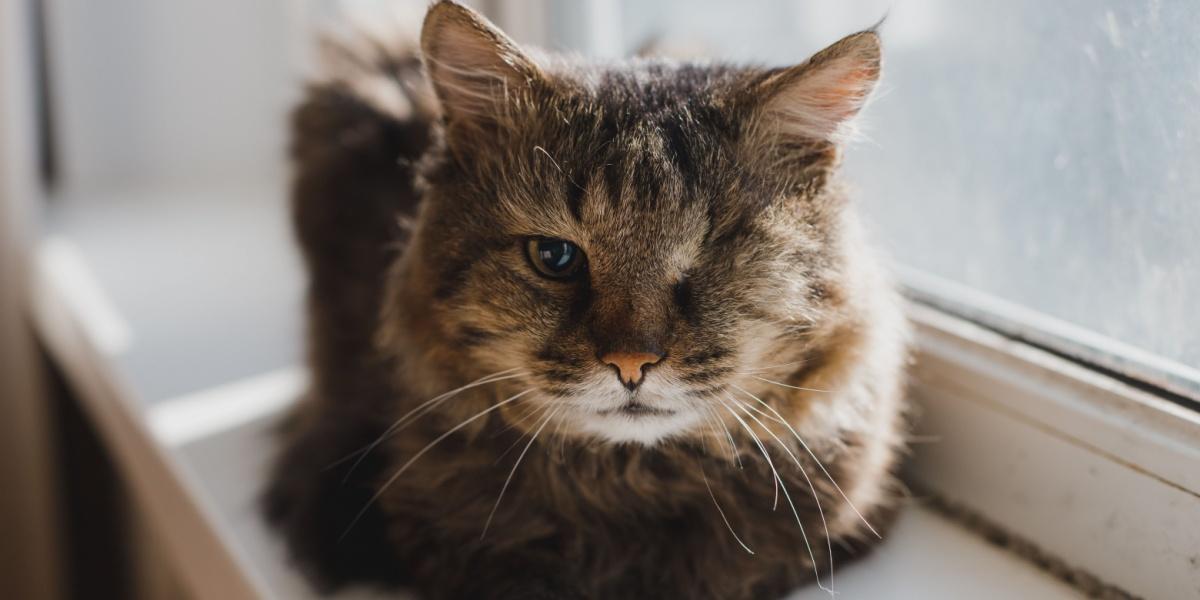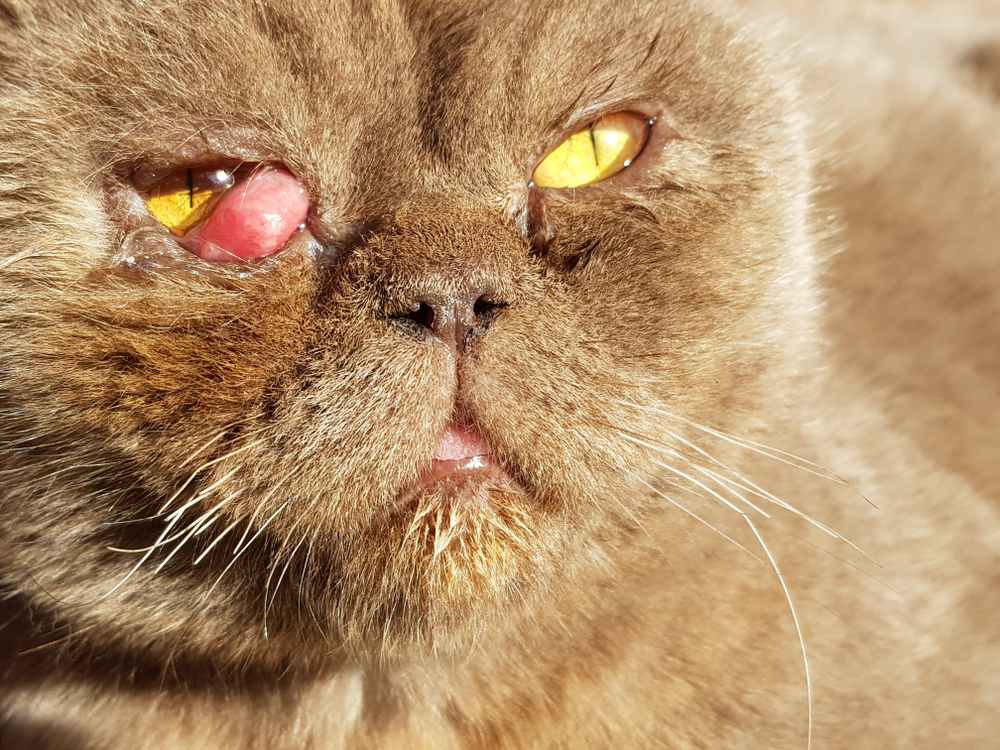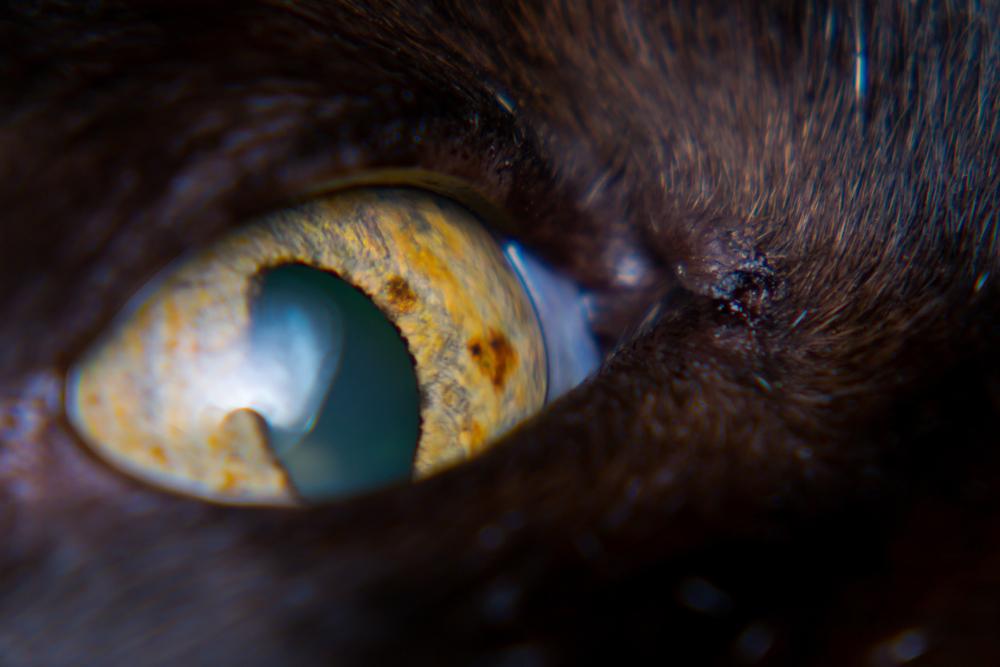
Treatment of eye cancer might involve surgical removal of the entire eye (called enucleation). yanatereshchenko_89 / Shutterstock.com
Eye cancer in cats is rare, but it does affect some cats. If you ever notice something unusual about your cat’s eye, such as redness, swelling, discharge, or squinting, it’s always best to get it checked out right away by a veterinarian. In this article, learn all about eye cancer in cats, including eye cancer symptoms and what treatments are available.
Types of Eye Cancer in Cats
Eye cancer can develop in cats, just as cancer can affect any other part of a cat’s body. Any part of the eye can be affected, but seven manifestations are more common.
- Eyelid neoplasia: A growth appears on the upper or lower eyelid. Eyelid neoplasias can be benign (such as adenomas) or malignant (such as adenocarcinomas, or squamous cell carcinomas, which are common in white cats especially).
- Third eyelid neoplasia: A growth appears on the third eyelid, which is a membranous structure located on the inner aspect of the eyelids, and is normally hidden from view.
- Conjunctival neoplasia: A growth develops on the conjunctiva, which is the soft tissue that lines the inside of the eyelids, the surface of the eyeball, and the lining of the eye socket.
- Iris tumors: A common type of infiltrative cancer can affect the iris or ciliary body and choroid ( the colored part of the eye, making up the tissue surrounding the pupil of the eye). This is known as malignant melanoma, iris melanomas, iris melanosis, uveal melanoma, or feline diffuse iris melanoma. It presents as an enlarging area of dark pigment on the iris caused by cancerous melanocytes (cells that produce pigment or melanin).
- Other types of tumor inside the eye: Examples include feline ocular post-traumatic sarcoma (FOPTS), which is a cancer that can occur in older cats with a longer term history of ocular trauma or chronic eye disease such as chronic uveitis. This tends to cause an opaque, white eye, with dramatic intraocular inflammation, destruction of the lens, and complete blindness.
- Tumors of other structures around the eye: The bone and soft tissues that make up the eye socket, enclosing the eyeball, can develop a range of different cancers, including spindle-cell tumors, round-cell tumors, fibrosarcomas, and osteosarcoma/chondrosarcoma.
- Lymphoma/lymphosarcoma: This generalized disease can appear as a type of cancer of the inside of the eyeball.
Causes of Eye Cancer

A protruding third eyelid may be caused by a cancerous growth in some cases. newsony / Shutterstock.com
In most cases, there is no known cause of eye cancer in cats. The usual suspected influences include genetics, exposure to certain chemicals, ultraviolet radiation (sunlight), other environmental factors, and specifically in lymphosarcoma, the feline leukemia virus (FeLV).
Symptoms of Eye Cancer
The main symptom is a change in the appearance of the affected eye. This might be subtle in the early stages (e.g., a change in color of the iris, or mild swelling of one of the eyelids), but it becomes more obvious as time passes and the cancer develops (e.g., a visible mass on an eyelid).
Sometimes the eyeball might be sunken (enophthalmos) or it might protrude (exophthalmos) if there is a growth at the back of the eye. The pupil shape might change, and secondary glaucoma might develop, following blockage of the iridocorneal angle by cancerous tissue obstructing the normal drainage of fluid from the eyeball.
In generalized conditions (such as lymphoma), other signs linked to the systemic disease might be noted (e.g., enlarged lymph nodes, lethargy, inappetence, etc.).
Diagnosis of Eye Cancer
If you take a cat that has signs that suggest eye cancer to a veterinarian, the following steps might be taken:
Detailed Medical History
Your vet will discuss a wide number aspects of your cat’s condition and overall health care. This might not seem directly relevant when your cat has an obvious problem (such as a growth on an eyelid) but it’s important that your vet gains a full understanding of your cat’s general health.
Your cat’s lifestyle might be discussed (indoors or outdoors, feeding routines, litter box habits, etc). You might be asked about any possible exposure to toxins (e.g., garden chemicals, toxic plants, medications, or flea treatments). Your vet will try to establish a timeline of your cat’s condition, going back weeks or months by asking when you first noticed any changes in the appearance of the eye.
Physical Exam
Your veterinarian will then check your cat over carefully, taking the body temperature, the heart rate, and listening to the heart and lungs with a stethoscope. They will palpate (feel) your cat’s entire body. This will all give your vet a sense of your cat’s general health.
Finally, the vet will focus on your cat’s eyes, examining them closely, often using a bright light, and also an ophthalmoscope (which includes magnification) to see as much fine detail as possible. The vet will examine any changes in the pigmentation on the iris, trying to determine whether the changes represent harmless freckles, or whether they could be more sinister lesions.
These days, your vet might also take a photograph (usually with a phone) to obtain a visual record of any changes. As well as checking for primary ocular tumors, the vet will also check for any signs of metastatic disease (signs of cancer spreading) through this detailed physical examination.
Routine Laboratory Tests
Your veterinarian might carry out some blood tests, including hematology (complete blood count) and a biochemistry profile (including liver, kidney and other parameters). Urinalysis is often carried out, too.
Your vet might suggest tests for common viral infections, such as feline leukemia (FeLV) and feline immunodeficiency virus (FIV), as part of a general health screen and because they can be linked to some generalized diseases, such as lymphoma, which might also be linked to eye cancer.
Diagnostic Imaging
Radiography (x-rays) of the skull and ultrasound of the eye might rarely be carried out, to find out more detail of any changes in the area that could be linked to eye cancer. Your vet might recommend chest x-rays and abdominal ultrasound to check for metastasis (spread of cancer). Occasionally, the vet might suggest advanced imaging, such as CT or MRI scans.
Biopsy
Rarely, a sample might be taken from the affected eye to obtain tissue for laboratory analysis, which is sometimes needed for a definitive diagnosis of some types of eye cancer. This sample collection might be combined with curative surgery. For instance, your vet might perform an excisional biopsy to remove an eyelid tumor, and the entire tumor might be sent away for histopathology).
Referral to a Veterinary Ophthalmologist

In the case of iris melanoma, the entire eye might be removed. Todorean-Gabriel / Shutterstock.com
Sometimes, the specialist skills and equipment of a veterinary ophthalmologist may be suggested, and your primary vet may set up a referral for your cat.
Treatments for Eye Cancer
The recommended treatment depends on the specific type of eye cancer. In general, cats with eye issues might be given eye drops (such as lubricants, anti-inflammatory, or antibiotic drops) to help to deal with infection and inflammation that might occur at the same time as the cancer as a type of complication.
For eyelid, third eyelid, and conjunctival tumors, your vet might recommend no treatment if the growth is not causing any issue (such as pressure on the eyeball) or they might recommend complete surgical excision. In some cases, this might involve just removing the tumor (sometimes using laser surgery if fine, delicate excisions are being undertaken). Cryosurgery (freezing) is sometimes an option.
In some cases, surgery could mean enucleation (surgical removal of the eye) as it might not be possible to remove the tumor completely without doing this. It’s important to remember that cats cope very well indeed with having only one eye.
Often, histopathology is carried out on the tissue that has been excised, allowing a definitive diagnosis to be reached, so that a detailed treatment plan and prognosis can be established.
Adjunctive, postoperative therapy, such as radiation therapy or chemotherapy, might be suggested for certain, specific cancers, but this is rare.
Iris melanosis is a type of infiltrative cancer of the iris, inside the eye itself, and because it cannot be excised in the same way as an eyelid tumor, enucleation (removal of the eyeball) might be recommended.
Lymphoma/ ymphosarcoma is a generalized systemic disease that requires a generalized approach, including multiagent chemotherapy. Your veterinarian will suggest an individualized approach depending on the specific details.
Cat Care Tips
When a cat has an eye problem of any kind, there are some things to consider to help make your cat’s care easier and less stressful for all.
- Monitoring: Cats with eye cancer need to be monitored carefully for recurrence of signs of illness, including a half-closed (or fully closed) eye, discharge, pawing at or rubbing the eye, or simply a change in appearance of the eye.
- Vet checks: Your cat will be re-examined regularly, as recommended by your veterinarian, to monitor progress. Often this starts fairly frequently (e.g., once a month), then reduces to every six months or even annually as time passes.
- Medication: Cats with eye cancer might be on multiple medications, including eye drops of different types, such as lubricants or antibiotics. Keeping a medication diary can be a useful way to keep track of doses, timings and any checkups.







